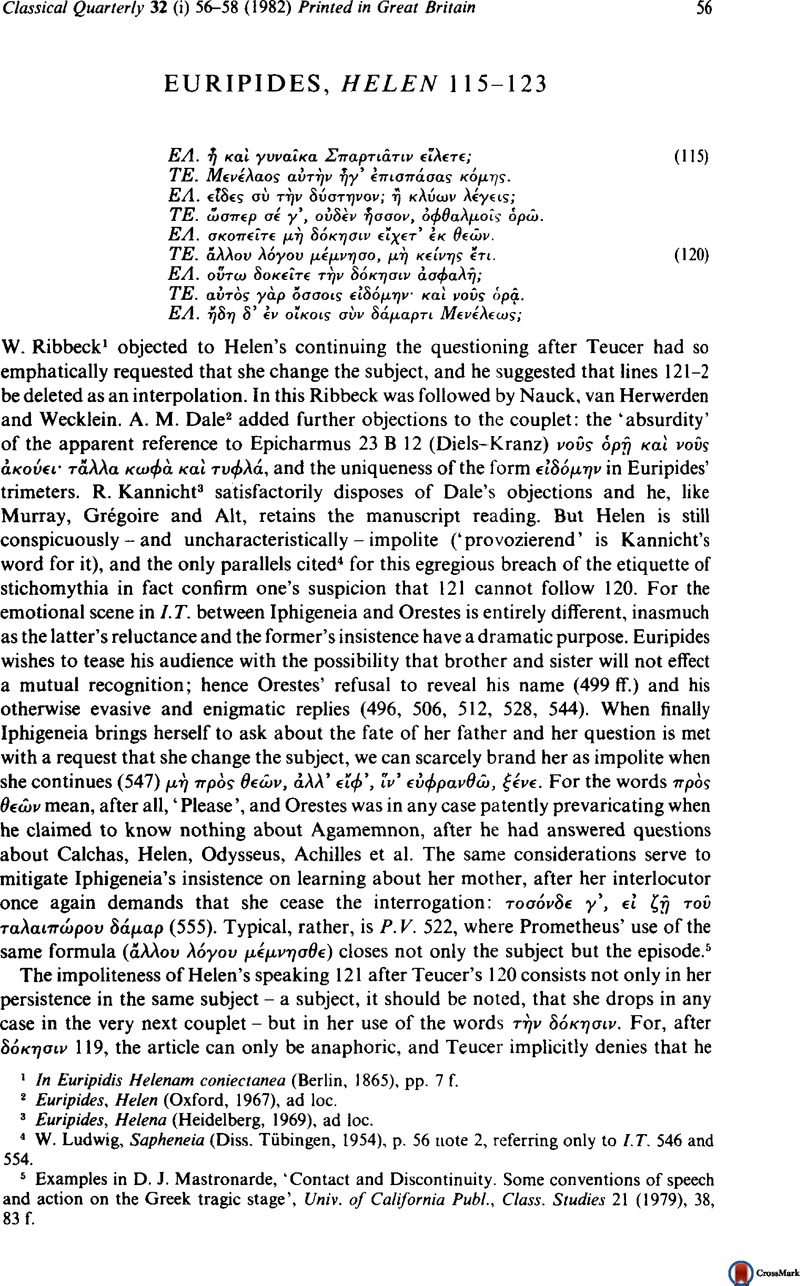No CrossRef data available.
Article contents
Euripides, Helen 115–123
Published online by Cambridge University Press: 11 February 2009
Abstract

- Type
- Research Article
- Information
- Copyright
- Copyright © The Classical Association 1982
References
2 Euripides, Helen (Oxford, 1967), ad loc.Google Scholar
3 Euripides, Helena (Heidelberg, 1969), ad loc.Google Scholar
4 Ludwig, W., Sapheneia (Diss. Tübingen, 1954), p. 56 note 2, referring only to I.T. 546 and 554.Google Scholar
5 Examples in Mastronarde, D. J., ‘Contact and Discontinuity. Some conventions of speech and action on the Greek tragic stage’, Univ. of California Publ., Class. Studies 21 (1979), 38, 83 f.Google Scholar
6 In addition to Kannicht's commentary see Schwinge, E.-R., Die Verwendung der Stichomythie in den Dramen des Euripides (Heidelberg, 1968), pp. 323–6.Google Scholar
7 I am not making any of this up. Here is Kannicht's version: ‘so sicher ist also der Wahn, den ihr da wähnt, daβ du nicht einmal mehr von dieser Frau reden willst?’ Kannicht does not comment on the implied variation in number.
8 cf. my edition of I.T. (Leipzig, 1981), p. vi. For other examples of transposition of lines in tragedy see Jackson, J., Marginalia Scaenica (Oxford, 1955), pp. 1 ff.Google Scholar No importance should be attached to the marginal note in L (on line 122) ⋯πίστησον. It is apparently equivalent to σημείωσαι and is in the hand of Simon Atumanus (for whom see Turyn, A., The Byzantine Manuscript Tradition of the Tragedies of Euripides (Urbana, 1957), pp. 226 f., with full bibliography).Google Scholar
9 τ***ν δóκησιν = τα***τα *** έδóκει ὑμ***ν. The article thus has the same function as in Ion 1602 and Or. 636.
10 Here Teucer apparently thinks he is clinching the matter by using a learned allusion. I am not entirely convinced that this is intended as a reference to Epicharmus. At any rate it is a perversion of the critical method first to identify obscure allusions and then condemn them (as A. M. Dale does) for their obscurity. Alternatively, Euripides might intend an allusion to the proverbial expression, known to us from Hdt. 1. 8. 2 and from a paraphrase of Heraclitus (22 B 101 a (Diels-Kranz)), that eyes are a more reliable witness than ears. F. Solmsen (CR 48 (1934), 119–21) shows that this passage is one of the many that ‘testify to the special interest Euripides shows, in this play more than in any other, in the questions of perception and cognition’.
11 No article, as in line 36.
12 Semon. 42 West: ![]() See also Il. 6. 234, 7. 360 ( = 12. 234), 9. 377, 12.255, 15. 724, 17. 469 f., 18. 311, 19. 137. Od. 14. 178, 19. 479, 20. 345 f., 23. 11 ff., Archil. 130 West, A. Pers. 472, 724 f. and Ajax in Sophocles, Heracles in Euripides; Dodds, E. R., The Greeks and the Irrational (Berkeley, 1951), pp. 3 ff.Google Scholar
See also Il. 6. 234, 7. 360 ( = 12. 234), 9. 377, 12.255, 15. 724, 17. 469 f., 18. 311, 19. 137. Od. 14. 178, 19. 479, 20. 345 f., 23. 11 ff., Archil. 130 West, A. Pers. 472, 724 f. and Ajax in Sophocles, Heracles in Euripides; Dodds, E. R., The Greeks and the Irrational (Berkeley, 1951), pp. 3 ff.Google Scholar


